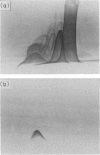Abstract
Modulation of activation of polyclonal IgM, IgG and IgM anti-DNA antibodies by plasma fibronectin (Fn) was studied because in some autoimmune diseases there appears to be a correlation between the increased level of Fn in the affected tissues and increased polyclonal B-cell activation. Fn caused a dose-dependent polyclonal activation of IgM, IgG and IgM anti-DNA antibody-secreting cells in cultures of mouse splenocytes. Fn significantly inhibited the generation of polyclonal antibodies by Fn-binding stimulants and did not significantly change the generation of polyclonal antibodies by the stimulants that do not bind Fn. Plasmin or trypsin digestion of Fn abolished both the polyclonal activating properties of Fn and the inhibitory effects of Fn that were selective for the Fn-binding polyclonal activators. Digestion of Fn with trypsin also generated immunosuppressive Fn fragments that inhibited polyclonal activation by both Fn-binding and non-binding bacteria. Under our culture conditions Fn or Fn digests were not mitogenic and had no effect on the mitogenicity of Fn-binding and non-binding stimulants. These results indicate that Fn can act as a polyclonal activator and that it can also modulate lymphocyte activation induced by other activators.
Full text
PDF





Images in this article
Selected References
These references are in PubMed. This may not be the complete list of references from this article.
- Carsons S., Mosesson M. W., Diamond H. S. Detection and quantitation of fibronectin in synovial fluid from patients with rheumatic disease. Arthritis Rheum. 1981 Oct;24(10):1261–1267. [PubMed] [Google Scholar]
- Carsons S., Parenti D., Lavietes B. B., Diamond H. S., Singer A., Boxer M. Plasma fibronectin in systemic lupus erythematosus: relationship to clinical activity, DNA binding and acute phase proteins. J Rheumatol. 1985 Dec;12(6):1088–1092. [PubMed] [Google Scholar]
- Clemmensen I. Fibronectin and its role in connective tissue diseases. Eur J Clin Invest. 1981 Jun;11(3):145–146. doi: 10.1111/j.1365-2362.1981.tb01831.x. [DOI] [PubMed] [Google Scholar]
- Czop J. K., Kadish J. L., Austen K. F. Augmentation of human monocyte opsonin-independent phagocytosis by fragments of human plasma fibronectin. Proc Natl Acad Sci U S A. 1981 Jun;78(6):3649–3653. doi: 10.1073/pnas.78.6.3649. [DOI] [PMC free article] [PubMed] [Google Scholar]
- Dziarski R. Comparison of in vitro and in vivo mitogenic and polyclonal antibody and autoantibody responses to peptidoglycan, LPS, protein A, PWM, PHA and Con A in normal and autoimmune mice. J Clin Lab Immunol. 1985 Feb;16(2):93–109. [PubMed] [Google Scholar]
- Dziarski R. Polyclonal activation of immunoglobulin secretion in B lymphocytes induced by staphylococcal peptidoglycan. J Immunol. 1980 Dec;125(6):2478–2483. [PubMed] [Google Scholar]
- Dziarski R. Preferential induction of autoantibody secretion in polyclonal activation by peptidoglycan and lipopolysaccharide. II. In vivo studies. J Immunol. 1982 Mar;128(3):1026–1030. [PubMed] [Google Scholar]
- Fröman G., Switalski L. M., Faris A., Wadström T., Hök M. Binding of Escherichia coli to fibronectin. A mechanism of tissue adherence. J Biol Chem. 1984 Dec 10;259(23):14899–14905. [PubMed] [Google Scholar]
- Godfrey H. P., Angadi C. V., Wolstencroft R. A., Bianco C. Localization of macrophage agglutination factor activity to the gelatin-binding domain of fibronectin. J Immunol. 1984 Sep;133(3):1417–1423. [PubMed] [Google Scholar]
- Homandberg G. A., Williams J. E., Grant D., Schumacher B., Eisenstein R. Heparin-binding fragments of fibronectin are potent inhibitors of endothelial cell growth. Am J Pathol. 1985 Sep;120(3):327–332. [PMC free article] [PubMed] [Google Scholar]
- Humphries M. J., Ayad S. R. Stimulation of DNA synthesis by cathepsin D digests of fibronectin. 1983 Oct 27-Nov 2Nature. 305(5937):811–813. doi: 10.1038/305811a0. [DOI] [PubMed] [Google Scholar]
- Hörmann H. Fibronectin--mediator between cells and connective tissue. Klin Wochenschr. 1982 Oct 15;60(20):1265–1277. doi: 10.1007/BF01727483. [DOI] [PubMed] [Google Scholar]
- Lanser M. E., Saba T. M. Correction of serum opsonic defects after burn and sepsis by opsonic fibronectin administration. Arch Surg. 1983 Mar;118(3):338–342. doi: 10.1001/archsurg.1983.01390030070011. [DOI] [PubMed] [Google Scholar]
- Lause D. B., Beezhold D. H., Doran J. E. Induction of lymphocyte blast transformation by purified fibronectin in vitro. J Immunol. 1984 Mar;132(3):1294–1299. [PubMed] [Google Scholar]
- Lause D. B., Doran J. E., Houston J. A., Beezhold D. H. Modulation of rat lymphocyte transformation by plasma fibronectin. J Reticuloendothel Soc. 1983 Dec;34(6):437–448. [PubMed] [Google Scholar]
- Lause D., Beezhold D. Regulation of lymphocyte reactivity by plasma fibronectin: cellular requirements. Immunol Invest. 1985 Aug;14(4):299–314. doi: 10.3109/08820138509022665. [DOI] [PubMed] [Google Scholar]
- Norris D. A., Clark R. A., Swigart L. M., Huff J. C., Weston W. L., Howell S. E. Fibronectin fragment(s) are chemotactic for human peripheral blood monocytes. J Immunol. 1982 Oct;129(4):1612–1618. [PubMed] [Google Scholar]
- Perri R. T., Kay N. E., McCarthy J., Vessella R. L., Jacob H. S., Furcht L. T. Fibronectin enhances in vitro monocyte-macrophage-mediated tumoricidal activity. Blood. 1982 Aug;60(2):430–435. [PubMed] [Google Scholar]
- Remold H. G., Shaw J. E., David J. R. A macrophage surface component related to fibronectin is involved in the response to migration inhibitory factor. Cell Immunol. 1981 Feb;58(1):175–187. doi: 10.1016/0008-8749(81)90159-3. [DOI] [PubMed] [Google Scholar]
- Scott D. L., Wainwright A. C., Walton K. W., Williamson N. Significance of fibronectin in rheumatoid arthritis and osteoarthrosis. Ann Rheum Dis. 1981 Apr;40(2):142–153. doi: 10.1136/ard.40.2.142. [DOI] [PMC free article] [PubMed] [Google Scholar]
- Switalski L. M., Ljungh A., Rydén C., Rubin K., Hök M., Wadström T. Binding of fibronectin to the surface of group A, C, and G streptococci isolated from human infections. Eur J Clin Microbiol. 1982 Dec;1(6):381–387. doi: 10.1007/BF02019939. [DOI] [PubMed] [Google Scholar]
- Switalski L. M., Rydén C., Rubin K., Ljungh A., Hök M., Wadström T. Binding of fibronectin to Staphylococcus strains. Infect Immun. 1983 Nov;42(2):628–633. doi: 10.1128/iai.42.2.628-633.1983. [DOI] [PMC free article] [PubMed] [Google Scholar]
- Vercellotti G. M., McCarthy J., Furcht L. T., Jacob H. S., Moldow C. F. Inflamed fibronectin: an altered fibronectin enhances neutrophil adhesion. Blood. 1983 Nov;62(5):1063–1069. [PubMed] [Google Scholar]
- Vuento M., Vaheri A. Purification of fibronectin from human plasma by affinity chromatography under non-denaturing conditions. Biochem J. 1979 Nov 1;183(2):331–337. doi: 10.1042/bj1830331. [DOI] [PMC free article] [PubMed] [Google Scholar]
- Wright S. D., Craigmyle L. S., Silverstein S. C. Fibronectin and serum amyloid P component stimulate C3b- and C3bi-mediated phagocytosis in cultured human monocytes. J Exp Med. 1983 Oct 1;158(4):1338–1343. doi: 10.1084/jem.158.4.1338. [DOI] [PMC free article] [PubMed] [Google Scholar]




